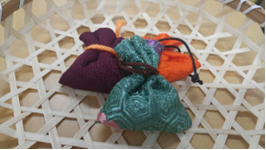~After Gozan Okuribi Extinguishing charcoal is a talisman and amulet~
Yoshie Doi

Every year, at the end of summer, we receive charcoal amulets to extinguish the Gozan Okuribi. It is handmade with time and effort, and in the early morning of August 17th, the morning after the Okuribi, he climbed the mountain, picked up extinguished charcoal, and made it after drying the charcoal.
It is not known exactly when the charcoal to extinguish the Gozan Okuribi began to be displayed at the entrance or secretly leaned against it as a talisman. No matter who I ask, I don’t know the details.
If you write your name and the name of a disease on a piece of goma wood and burn it in an bonfire, your illness will be cured. There is a saying that it will
You can see the actual product at shops along the approach to Ginkakuji Temple. The charcoal used to extinguish the Okuribi is believed to ward off misfortune, and is often seen wrapped in Japanese paper and tied with mizuhiki (traditional Japanese paper cord) and displayed at doorways.
In Kyoto, at the end of the year, there is a custom to wrap Horikawa burdock root in paper and tie it with mizuhiki as a year-end gift.
During the Edo period, pine charcoal was used in folk medicine as a gastrointestinal remedy. “Recently, more and more people carry it around in a small bag as a talisman, and some people place it on a small plate as a decoration.
In Kyoto, even if the towel becomes thin and tattered, it is pierced with thread and turned into a rag. Even if it becomes unusable with a rag, like drying to remove oil stains, an eco-friendly cycle has been rooted in our lives for a long time.
The end of document
